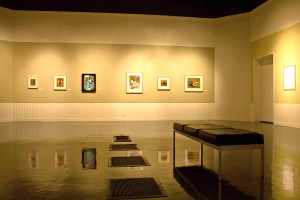Fisher unveils new feminist art display
An exploration of identity comes to campus in the traveling exhibit “A Complex Weave: Women and Identity in Contemporary Art,” now on display until Dec. 1 at the USC Fisher Museum of Art.

A woman’s perspective · “A Complex Weave: Women and Identity in Contemporary Art,” now on display at the USC Fisher Museum of Art, features the diverse works of 16 different female artists. – Joseph Chen | Daily Trojan
Inspired by feminist art, the exhibit brings together more than 40 works by 16 women artists to “throw some additional light on the complex weave of gender and identity in contemporary art,” said co-curator Martin Rosenberg, professor of art history at Rutgers University.
Nearly three years old, the exhibit, curated by Rosenberg and Dr. J. Susan Isaacs, professor of art history at Towson University, arrived at USC through the services of Curatorial Assistance, a company that manages traveling exhibitions worldwide.
The unique variety of works focus on topics of ethnicity, age, sexual orientation, culture, geography and religion. The intricate connections between these facets of identity are shown through film photography, video production, sculpture, embroidery, installation and metalwork. Displayed together, they carry strong messages for the global feminist movement of today.
The exhibit also showcases the diversity of the artists themselves.
“It’s a women-embrace-art kind of showcase,” Fisher’s Education and Programs Coordinator Vanessa Jorion said. “There are no two artists who really come from the same place. You have everything from Chinese, Japanese, Moroccan, New Yorker and religious-wise — Orthodox Jewish and Hindu from India. It’s all about how these women bring these aspects of identity to their art, how it’s woven together, united in a sense of not defining identity but how they showcase their identity.”
In “Angel Island Shhh,” Chinese-American artist Flo Oy Wong illustrates conflicted emotions of growing up in two different cultures through a mixed media of U.S. flags, rice sacks, sequins and thread. In her own distinctive style, Moroccan artist Lalla Essaydi captures the complex reality of the Arab female identity through Islamic calligraphy with representations of the female body.
The exhibit also illustrates how the extraordinary can, at times, emerge from the seemingly mundane. African-American artist Sonya Clark’s “Curls,”
which features ceiling-high strands of curled hair all made from interconnected black combs, dangles in a corner. On the wall opposite, Mexican-American artist Blanka Amezkua’s embroidery boldly stands out. Through a traditional “female” craft, Amezkua shatters the images of passive women drawn in the comic books of her childhood, reconstructing them as defiant and physically strong.
“Even though the works are done by women artists, everyone can appreciate it because we all associate with identity,” Jorion said. “You can walk away with a little appreciation and enlightenment. There’s something for everyone to connect with.”
The 16 featured artists include Amezkua, Clark, Oy Wong, Sarah Amos, Helène Aylon, Siona Benjamin, Zoë Charlton, Annet Couwenberg, Essaydi, Judy Gelles, Sharon Harper, Julie Harris, Fujiko Isomura, Tatiana Parcero, Philemona Williamson and April Wood.
